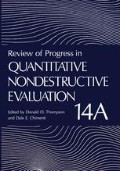Abstract
Adhesively bonded structures have found increased acceptance in both military and commercial aircraft. Reliability of these aircraft structures is of paramount importance. This issue is especially important for aging aircraft, which are very often in service beyond their stipulated lifetime. Joints are exposed to various combinations of cumulative mechanical fatigue, thermal fatigue and environmental conditions. In addition, voids inherent in the adhesive joint cause sites of stress concentration and coalesce to form disbonds when the joints are loaded. Simultaneous presence of these disbonds in the same structural element will result in a loss of its load bearing strength. Moisture can also attack the primary bonds between the substrate and the adhesive decreasing the joint’s interfacial strength. Periodic cycling and environmental factors lead to disbond propagation and premature failure of the joints. The effect of cumulative cycling on disbonding and its propagation in adhesive joints is an important subject, which has been the focus of this study.
Access this chapter
Tax calculation will be finalised at checkout
Purchases are for personal use only
Preview
Unable to display preview. Download preview PDF.
References
F.H. Chang et al., IEEE Trans. Sonics Ultrason, SU-23(5), (1976), p. 334.
G.A. Alers et al., Materials Evaluation, 35(4), p. 77, (1977).
P.B. Nagy and L. Adler, J. Appl. Phys., 66(10), (1989) p.4658.
Y. Barcohen and A.K. Mal, in Review of Progress in QNDE, Vol. 9, eds. D.O. Thompson and D.E. Chimenti (Plenum, New York, 1990), p. 1271.
P. Cawley and M.J. Hodson, in Review of progress in QNDE, Vol. 8, eds. D.O. Thompson and D.E. Chimenti (Plenum, New York, 1989), p. 1377.
S.I. Rokhlin, in Adhesive Joint, Formation, Characterization, and Testing, ed. K.L. Mittal (Plenum, New York, 1982), p. 307.
R.B. Thompson and D.O. Thompson, J. Adhesion Sci. Tech. 5, p. 583, (1991).
G.M. Light and H. Kwun, SwRI Project 17-7958-838, Southwest Research Institute, San Antonio, TX, (June 1989).
W.J. Xu et al., in Review of progress in QNDE, Vol. 13, eds. D.O. Thompson and D.E. Chimenti (Plenum, New York, 1994), p. 1499.
D.C. Worlton, J. Appl. Phys., 32, 967, (1961).
H. Aglan et al., in Review of progress in QNDE, Vol. 13, eds. D.O. Thompson and D.E. Chimenti (Plenum, New York, 1994), p. 1563.
P. Cawley and T. Pialucha, in Review of progress in QNDE, Vol. 13, eds. D.O. Thompson and D.E. Chimenti (Plenum, New York, 1994), p. 1523.
L. Molent and R. Jones, Eng. Fract. Mech., 44,4, p. 627, (1993).
L.D. Favro, T. Ahmed, X. Wang, Y.X. Wang, H.J. Jin, P.K. Kuo and R.L. Thomas, in Review of Progress in QNDE, Vol. 12, eds. D.O. Thompson and D.E. Chimenti (Plenum, New York, 1993), pp. 2021–2025.
H. Aglan et al., J. of Adhesion Sci. and Tech., in press.
Author information
Authors and Affiliations
Editor information
Editors and Affiliations
Rights and permissions
Copyright information
© 1995 Plenum Press, New York
About this chapter
Cite this chapter
Aglan, H. et al. (1995). Cumulative Fatigue Disbond of Adhesive Joints and its Detection using Thermal wave Imaging. In: Thompson, D.O., Chimenti, D.E. (eds) Review of Progress in Quantitative Nondestructive Evaluation. Springer, Boston, MA. https://doi.org/10.1007/978-1-4615-1987-4_51
Download citation
DOI: https://doi.org/10.1007/978-1-4615-1987-4_51
Publisher Name: Springer, Boston, MA
Print ISBN: 978-1-4613-5819-0
Online ISBN: 978-1-4615-1987-4
eBook Packages: Springer Book Archive

